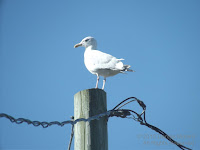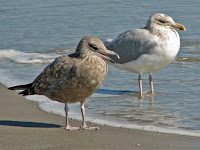HERRING GULL
HERRING GULL (Larus smithsonianus) – (See images below)
DESCRIPTION: The American Herring Gull adult is mainly grey and white, with the grey on top and the white for the under parts. The wing tips are black. The bill is yellow with a red spot in the middle of the lower mandible. The legs are pink. Sexes are similar, but the juveniles have a light mottled brown plumage, and will only reach adult plumage after four years. This gull is a large species at about 2 feet long (60 cm).
VOICE: https://www.xeno-canto.org/species/Larus-smithsonianus – The distinctive plaintive call of this gull is similar to a complaint and is associated with the sea (for example it is used in some relaxation audio recordings).
NAME: The proper name of this bird should be ‘American’ Herring Gull, because there’s also a ‘European’ Herring Gull. The English name ‘Gull’ would have its origins in Old Celtic ‘Gullan’ and other languages, including Latin ‘gula’ for throat. As per Choate this would be related to the gull’s ‘indiscriminate’ scavenging habits, its ‘willingness to swallow almost anything’ (think ‘gullible’). This gull was given the name ‘Herring’ because that fish is part of its diet.
The Latin genus name ‘Larus’ refers to a large seabird, and the species name ‘smithsonianus’ was given in honor of James Smithson, an English chemist who donated money that allowed the creation of the Smithsonian Institution.
HABITAT: The habitat of the American Herring Gull is widespread – in fields or wetlands, at lakes or beaches, at garbage dumps and other areas in cities where there’s garbage, or at sea following ships along the coasts for fish and other food scraps.
DIET: Herring gulls are omnivorous, i.e. will feed on invertebrates, fish, molluscs, small birds and garbage. They are also scavengers if given the opportunity. One way they access the flesh of molluscs in shells is by flying above asphalt roads and dropping them, in order to break the shells.
NESTING: This gull will usually nest in colonies near the coast. The nest is a scrape on the ground. About three eggs of varying colors are laid. Both parents are involved in all parts of nesting and caring for the young.
DISTRIBUTION: The breeding range of the American Herring Gull encompasses most of Canada except the high Arctic and the Rockies, Alaska and Siberia. It is a year-round resident around the Great Lakes and the eastern coast of the USA. The groups from Siberia are migrating to Japan and coastal areas of China. The birds from northern Canada migrate to the southern part of the USA and the coastal areas of North America. Hawaii visitor.
DISTRIBUTION MAP: https://en.wikipedia.org/wiki/American_herring_gull#/media/File:Larus_smithsonianus_map.svg
ON PEI: Herring gulls are widespread in Prince Edward Island and are year-round residents.
GULLS ON HAWAII: Gulls are not long time residents or indigenous to Hawaii. They are continental species and the Hawaiian Islands don’t seem to provide them with the habitat they need. Those birds that do make it however have either flown on their own or got blown off course, or hitched a ride on ships. In either case they don’t stay for long.
CONSERVATION: Before being protected, herring gulls were hunted for their eggs and feathers. Their population has been steadily declining over the last few decades, owing in part to better fish waste management from fisheries. The species however is still considered as of ‘least concern’ by the IUCN.
NOTES: Herring gulls gather in groups to roost on city rooftops near food sources.
SIMILAR SPECIES: European Herring Gull, Ring-billed Gull
REFERENCES: https://en.wikipedia.org/wiki/American_herring_gull
https://www.allaboutbirds.org/guide/Herring_Gull/id
https://www.mba-aom.ca/jsp/toc.jsp
http://www.birdweb.org/birdweb/bird/herring_gull
https://www.audubon.org/field-guide/bird/herring-gull
http://www.hww.ca/en/wildlife/birds/herring-gull.html
The same birds as above are seen in this video below. The bird that was standing on one leg probably got tired and decided to lie on the ice like the others. They were all keeping an eye open.
DESCRIPTION: The American Herring Gull adult is mainly grey and white, with the grey on top and the white for the under parts. The wing tips are black. The bill is yellow with a red spot in the middle of the lower mandible. The legs are pink. Sexes are similar, but the juveniles have a light mottled brown plumage, and will only reach adult plumage after four years. This gull is a large species at about 2 feet long (60 cm).
VOICE: https://www.xeno-canto.org/species/Larus-smithsonianus – The distinctive plaintive call of this gull is similar to a complaint and is associated with the sea (for example it is used in some relaxation audio recordings).
NAME: The proper name of this bird should be ‘American’ Herring Gull, because there’s also a ‘European’ Herring Gull. The English name ‘Gull’ would have its origins in Old Celtic ‘Gullan’ and other languages, including Latin ‘gula’ for throat. As per Choate this would be related to the gull’s ‘indiscriminate’ scavenging habits, its ‘willingness to swallow almost anything’ (think ‘gullible’). This gull was given the name ‘Herring’ because that fish is part of its diet.
The Latin genus name ‘Larus’ refers to a large seabird, and the species name ‘smithsonianus’ was given in honor of James Smithson, an English chemist who donated money that allowed the creation of the Smithsonian Institution.
HABITAT: The habitat of the American Herring Gull is widespread – in fields or wetlands, at lakes or beaches, at garbage dumps and other areas in cities where there’s garbage, or at sea following ships along the coasts for fish and other food scraps.
DIET: Herring gulls are omnivorous, i.e. will feed on invertebrates, fish, molluscs, small birds and garbage. They are also scavengers if given the opportunity. One way they access the flesh of molluscs in shells is by flying above asphalt roads and dropping them, in order to break the shells.
NESTING: This gull will usually nest in colonies near the coast. The nest is a scrape on the ground. About three eggs of varying colors are laid. Both parents are involved in all parts of nesting and caring for the young.
DISTRIBUTION: The breeding range of the American Herring Gull encompasses most of Canada except the high Arctic and the Rockies, Alaska and Siberia. It is a year-round resident around the Great Lakes and the eastern coast of the USA. The groups from Siberia are migrating to Japan and coastal areas of China. The birds from northern Canada migrate to the southern part of the USA and the coastal areas of North America. Hawaii visitor.
DISTRIBUTION MAP: https://en.wikipedia.org/wiki/American_herring_gull#/media/File:Larus_smithsonianus_map.svg
ON PEI: Herring gulls are widespread in Prince Edward Island and are year-round residents.
GULLS ON HAWAII: Gulls are not long time residents or indigenous to Hawaii. They are continental species and the Hawaiian Islands don’t seem to provide them with the habitat they need. Those birds that do make it however have either flown on their own or got blown off course, or hitched a ride on ships. In either case they don’t stay for long.
CONSERVATION: Before being protected, herring gulls were hunted for their eggs and feathers. Their population has been steadily declining over the last few decades, owing in part to better fish waste management from fisheries. The species however is still considered as of ‘least concern’ by the IUCN.
NOTES: Herring gulls gather in groups to roost on city rooftops near food sources.
SIMILAR SPECIES: European Herring Gull, Ring-billed Gull
REFERENCES: https://en.wikipedia.org/wiki/American_herring_gull
https://www.allaboutbirds.org/guide/Herring_Gull/id
https://www.mba-aom.ca/jsp/toc.jsp
http://www.birdweb.org/birdweb/bird/herring_gull
https://www.audubon.org/field-guide/bird/herring-gull
http://www.hww.ca/en/wildlife/birds/herring-gull.html
 |
| Herring gull, PEI, Canada |
 |
| Herring gulls resting on ice, PEI, Canada |
 |
| Herring gulls, adult and juvenile, NC photo by Dick Daniels |